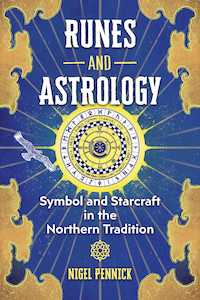
Runes and Astrology: Symbol and Starcraft in the Northern Tradition, by Nigel Pennick
Destiny Books, 978-1644116005, 223 pages, June 2023
I’m just going to say it: Runes and Astrology: Symbol and Starcraft in the Northern Tradition by Nigel Pennick is an absolute must have if there is even an inkling of curiosity about Northern Tradition runes and their kin. This book is an absolute treasure trove of insight, magic, and tradition and is worth every single penny. If a previous edition sits on your shelf, move it over and put this one beside it.
Nigel Pennick is an authority on ancient belief systems, traditions, runes, and geomancy and has traveled and lectured extensively in Europe and the United States. He is the founder of the Institute of Geomantic Research and the author and illustrator of more than 60 books, including Elemental Magic, Magic in the Landscape, and The Ancestral Power of Amulets, Talismans, and Amulets. His level of insight into this tradition is unparalleled, and that insight resonates throughout this latest book.
One thing I love about a good book is the introduction and the appendices. Runes and Astrology does not disappoint on either front. The introduction is well layered with history and practical application is evenly distributed throughout. I love it when authors set out their intentions for the rest of the book within the context of the introduction and that’s precisely what Pennick has done. Glorious.
The Table of Contents is neatly set out and covers the topics one would assume to find. There’s a chapter on basics which is extremely well written and very informative. Titled “The Basic Concepts”, this first chapter is anything but. Honestly, you could read this one chapter and you’d know more about runes and their history and use than most people. Starting with linking runes with the idea that everything exists simultaneously with everything else, Pennick states clearly that “nothing in existence exists separately – everything that is present in the universe is continuous with its surroundings and is the product of its own historical circumstances.”1
Pennick continues:
“Wherever we choose to look, there is nothing that exists now, or that has existed in the past, that is not the result of a multiplicity of events and processes, traceable back ultimately to the formation of the world eons agon. Because of this, it is only by studying history in the widest sense that we can begin to get some insights into the true meaning of anything.”2
By tracing the lineage of the runes and the system they are part of, Pennick explores the concept of using history as a way to understand how things became what they are currently. It’s a brilliant method of writing and gives rise to a whole new way of thinking about runes and their place within a divination system. Personally, I enjoy learning about the history of things, whether they are divination systems, magical paths, or ingredients. For me, knowing how we came to use such things is as useful as knowing how to apply them practically in today’s world.
There’s an excellent chapter about runes and their meanings, but for me the chapter to really get into is the chapter titled “The Runes, the Planets, and Their Cycles.” Connecting the runes to various planets in the context of their deeper meanings is fascinating. Pennick takes time to clearly explain the links made between the runes and the various planets and satellites generally accepted as rulers of both hours and days of the current way of timekeeping.
Pennick’s style of writing is both informative and descriptive and lends itself well to the topics covered in this book. I found it both a delight to read because of the easy style of writing and also very interesting as there is so much information present in each chapter.
Do yourself a favor and pick Runes and Astrology up. Even if you only have a passing interest in astrology or runes, this book contains so much information through both the individual chapters and the appendices that follow, you will be glad you have it on your shelf as a reference.

Sarrah October Young is a writer and practising witch who wished she could do stand-up comedy. When she isn’t writing or witching, she can be found posting about her cats on IG @therealoctober.
